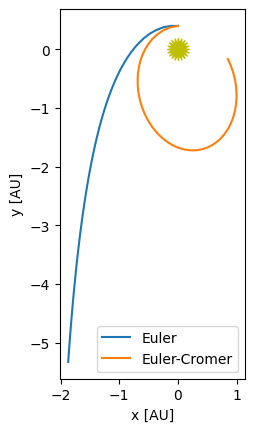ODEs and Conservation#
As we saw now in a few examples, the Runge-Kutta methods do not conserve energy. For integrating over very long timescales, this can be problematic.
Let’s explore some other methods to get a feel for what it means to be conservative.
import numpy as np
import matplotlib.pyplot as plt
Euler-Cromer method#
The Euler-Cromer method or semi-implicit Euler method is a first order method very similar to the first-order Euler, but with one simple change. The update is:
Note
The only change is that we use the updated velocity, \({\bf v}^{n+1}\) in the expression to get the new position. This is not an implicit method, since we already have the new velocity from the first expression.
Implementation#
Let’s integrate our planet and compare this to the original Euler method.
We’ll use the same helper module to provide the core functions we need, these are now in a module orbit_util.py.
import orbit_util as ou
Here’s the original Euler method
def euler_orbit(state0, tau, T):
"""integrate an orbit given an initial position, pos0, and velocity, vel0,
using first-order Euler integration"""
times = []
history = []
# initialize time
t = 0
# store the initial conditions
times.append(t)
history.append(state0)
# main timestep loop
while t < T:
state_old = history[-1]
# make sure that the last step does not take us past T
if t + tau > T:
tau = T - t
# get the RHS
ydot = ou.rhs(state_old)
# do the Euler update
state_new = state_old + tau * ydot
t += tau
# store the state
times.append(t)
history.append(state_new)
return times, history
and here’s Euler-Cromer
def euler_cromer_orbit(state0, tau, T):
"""integrate an orbit given an initial position, pos0, and velocity, vel0,
using first-order Euler-Cromer integration"""
times = []
history = []
# initialize time
t = 0
# store the initial conditions
times.append(t)
history.append(state0)
# main timestep loop
while t < T:
state_old = history[-1]
# make sure that the last step does not take us past T
if t + tau > T:
tau = T - t
# get the RHS
ydot = ou.rhs(state_old)
# do the Euler update
unew = state_old.u + tau * ydot.u
vnew = state_old.v + tau * ydot.v
xnew = state_old.x + tau * unew
ynew = state_old.y + tau * vnew
state_new = ou.OrbitState(xnew, ynew, unew, vnew)
t += tau
# store the state
times.append(t)
history.append(state_new)
return times, history
state0 = ou.initial_conditions()
tau = 0.01
tmax = 1.0
times_euler, history_euler = euler_orbit(state0, tau, tmax)
times_ec, history_ec = euler_cromer_orbit(state0, tau, tmax)
fig = ou.plot(history_euler, label="Euler")
ou.plot(history_ec, ax=fig.gca(), label="Euler-Cromer")
fig.gca().legend()
<matplotlib.legend.Legend at 0x7fdf405c5d30>

These are both first-order accurate, but notice how much better the Euler-Cromer solution is!
Angular momentum#
Let’s consider the angular momentum of the orbit as evolved by Euler-Cromer.
Angular momentum / unit mass in the orbit plane is:
Using the Euler-Cromer evolution:
We can compute the new angular momentum
We see that, for a central potential, since \({\bf a} \times {\bf r} = 0\), the new (discrete) angular momentum is equal to the old angular momentum in this scheme (to \(\mathcal{O}(\tau^2)\)).
So the Euler-Cromer method does better because it has a notion of conservation.
Note that there is still error, and it will converge globally first order.
Eccentric orbit#
Let’s look at an eccentric orbit:
a = 1.0
e = 0.6
# perihelion velocity
x0 = 0.0 # start at x = 0 by definition
y0 = a * (1.0 - e) # start at perihelion
u0 = -np.sqrt((ou.GM/a)* (1.0 + e) / (1.0 - e))
v0 = 0.0
state0 = ou.OrbitState(x0, y0, u0, v0)
times_euler, history_euler = euler_orbit(state0, tau, tmax)
times_ec, history_ec = euler_cromer_orbit(state0, tau, tmax)
fig = ou.plot(history_euler, label="Euler")
ou.plot(history_ec, ax=fig.gca(), label="Euler-Cromer")
fig.gca().legend()
<matplotlib.legend.Legend at 0x7fdf402d4440>



